

2 SENIOR DESIGN 024 SHOWCASE
WELCOME
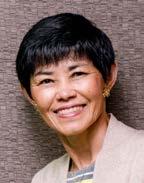
Welcome to Gonzaga University’s School of Engineering and Applied Science (SEAS) 2024 Design Expo Day. We’re celebrating an important milestone in our student’s academic journey—their senior design projects. To transform innovative ideas into proofs-of-concept and prototypes, our students learned about project planning, communications, report writing, budgeting, and resource management.
I am deeply grateful to all those who helped our seniors achieve this daunting feat—supervising faculty, industry sponsors, numerous community members, the SEAS Capstone Committee, outgoing Academic Director Ryan Kellogg, Manufacturing Technology Center Engineer Beau Grillo, the Dean’s office staff, Mary Hunt and Mindy Ratcliffe, and the incoming Academic Director Ted Zhang.
To our seniors, congratulations on completing this monumental effort. Your design teams have worked hard all year long to take the project from ideation to the physical realization you are presenting today. Thank you for your dedication and commitment to excel in this demanding but gratifying pursuit. I wish you much success in all your future endeavors
Go Zags!
Karlene A. Hoo, Ph.D. Dean and Professor, School of Engineering & Applied Science
Welcome from the Academic Director

Congratulations to our Senior Design graduates! As the incoming Academic Director, I am extremely proud of our students and humbled by their ingenuity, resourcefulness, and perseverance.
To echo Dean Hoo, I am deeply appreciative of the support and enthusiasm of our sponsors, advisors, and Design Advisory Board members. I also want to extend a special thank-you to Ryan Kellogg, the outgoing Academic Director, for laying the foundations of this year’s Senior Design experience. I would like to thank the dean’s office, the Capstone Committee, the MTC Lab, and all faculty and staff for their steadfast support of our Senior Design program.
Seniors, please keep in touch with us and send us word of your journeys and successes. On behalf of everyone who’s had the pleasure of working with you, we wish you all the best in your future endeavors!
Ted Zhang
Academic Director, Center for Engineering Design & Entrepreneurship
| Gonzaga School of Engineering & Applied Science
COMPUTER SCIENCE CS24-01 | Boxy Software Development 4 CS24-02 | Wildfire Resource Simulator 4 CS24-03 | Power Line Protection System 5 CS24-04 | AI Filtering Tool 5 CS24-05 | TATS Data Model for a Digital Thread .................. 6 CS24-06 | Conference Room Scheduling App 6 CS24-07 | Rental Prediction System ......................................... 7 CS24-08 | Strip Defect Detection 7 CS24-09 | Optical Character Reader ........................................ 8 CS24-10 | Device and Software Inventory Tool 8 CS24-11 | Language Translation Minigame 9 CS24-12 | Bank Fee Analytics System 9 CS24-13 | Smartphone Spectrum Viewer 10 CS24-14 | Embedded IoT Protocols 10 CIVIL ENGINEERING EN24 -20 | Upriver Dam Break Evaluation................................ 11 EN24 -21 | Drinking Water System Resilience to Wildfires ..... 11 EN24-22 | Bringing Netherland’s Sustainable Practices ................ to Gonzaga 12 EN24-23 | Arlington Municipal Airport Taxiway Reconstruction 12 EN24-24 | Trent Bridge Replacement and Construction 13 EN24-25 | Stormwater Quality Improvement Study 13 EN24-26 | Wrong Way Driving Design Review of I-90 in Spokane 14 EN24-27 | Fire Training Facility Structural Design 14 EN24-28 | East Silver Creek Bridge Design 15 ELECTRICAL & COMPUTER ENGINEERING EN24-4 0 | Fire Extinguishing System Detection & Control ................... 15 EN24-41 | Dental Composite Dispenser 16 EN24-42 | Lateral Reinstatement System 16 EN24-43 | 3D Ultrasound Processing 17 EN24-44 | Concert for the Deaf 17 EN24-45 | Plumbing Insulation Tech Integration 18 EN24-46 | Helical Antenna Array Evolution 18 MECHANICAL ENGINEERING EN24-50 | Fire Extinguishing System Mechanical Design 19 EN24-51 | Aircraft Float Manufacturing Redesign .................................. ............................ 19 EN24-52 | Rover Challenge Arm & Gripper 20 EN24-53 | High-Flow Fuel Transfer System 20 EN24-54 | Metallic Seal Stretch-Former 21 EN24-55 | Sustainable Seat Cushion 21 EN24-56 | Aircraft Interior Parts Recycling 22 EN24-57 | Electric Wing Deicing 22 EN24-58 | Fastener Push In vs. Rivet Gun Installation II .... 23 EN24-59 | Universal Personal Flotation Device 23 EN24-60 | Scrap Tub Redesign 24 EN24-61 | Modular Chlorine Gas Controller 24 EN24-62 | Multi-Station Wear Tester 25 ENGINEERING MANAGEMENT EN24 -70 | West Seattle Bridge 25
CONTENTS
2
THANK YOU SPONSORS
Sponsoring organizations provide projects, resources, and professional influence to the senior design teams. Diverse sponsors provide a wide range of project options, giving students a more engaging learning experience.
2Barrels
Avista
Boeing City of Spokane Coffman Engineers
David Welton DDS
DOWL
»
Dragon Jacket
Dwight Brayton
Edo Floats
» » » »
»
Fire Armada
Garco/WSDOT
Gonzaga University
Gravity Jack
GU Engineering Management
GU Human Physiology
GU Mechanical Engineering
GU Robotics
GU SARL
GU/MSU
Horrocks Engineers
» » » » » » »
» » »
Itron
Jetseal
Kaiser Aluminum Medcurity
Michels Trenchless
Orebaugh Enterprises
Pangeon
Phillip Pintor
Tatitlek Technologies, Inc
Treasury4
DESIGN ADVISORY BOARD (DAB)
Design Advisory Board members are experienced professionals who volunteer their time and talents with the teams, offering diverse guidance and mentorship.
» » »
Skye Aldrich
Brent Barr
Stu Barton »
Les Bohush
TJ Bolser
Dustin Cassell
Annikki Chamberlain
Justin Chin
Brenna Doll
Terra Donley
J.J. Doria
Bri Dorie
Dave Duncan
Jennifer EmersonMartin
Lee Firth
Ryan Floyd
Lindsay Gilbert
Karie Gullickson
Jay Hassell
Kaitlyn Helsing
Michael Herzog
Karen Hills
Andrew Flagstead » » » » » » » »
Wayne Johnson
Kayla Kassa
Jeb Kilfoyle
Jacob Krantz
Katie Larimer
Adam Hutchinson » » » » » » »
Colleen Little
Rebecca O’Sullivan » » » » » » »
Kaela Mansfield
Jared Marshall
Andrew Matsumoto
Dawson Matthews
Glorilyn Maw
Alex Maxwell
Russell Mann » » » » » » » »
Karly McCauley
Jesse Phillips
Philip Pintor
Doug Pooler
Vince Poxleitner
Nick Questad
Duane Radmer
Eric Ryan » » » » » » » »
Emily Sackmann
Brandon Sargent
Scott Schwartz
Damiano Seghetti
Kalika Singh
James Stevenson
Michael Tobias
Kyle Umlauf
Melissa Verwest
Richard Weeks
James Weston
Byrl Williams
Dillon Turnbull » Bob Turner » » » » » »
Roy Wortman
This week, Spokane commemorates the 50th Anniversary of the opening of EXPO ‘74. This world’s fair reshaped the downtown core and championed environmental conservation. The Senior Design projects featuring the iconic stylized Mobius strip, symbolizing the EXPO, mark an emphasis on environmental awareness and ecology.
Senior Design Expo 2024
» » » » » » »
»
» »
» » » » »
»
»
» » »
» » » » » » »
| 3
CS24-01 Boxy Software Development

» Nathan Bashant-Coon, Comp. Sci. & Comp. Thinking
Santiago Calvillo, Computer Science
Brandon Miller, Computer Science
James Vuong, Computer Science
Advisor: Daniel Lenz
DAB: Jacob Krantz
Sponsor: Dwight Brayton
The CS24-01 team collaborated with Dwight Brayton of d2b Inc. to develop Boxy, an innovative online messaging system aimed at providing online communication. Unlike traditional messaging devices, such as smartphones which can be expensive investments nowadays, Boxy offers a cost-effective alternative by utilizing an Android mobile application and a Raspberry Pi device for seamless communication. CS24-01 was tasked with developing an app to record voice messages on the app, send them to the Boxy device over Wi-Fi, and then forward the messages to a paired Bluetooth device if needed. This project was developed primarily using Java and Python. The team’s project provides a budgetfriendly yet comprehensive messaging solution, catering to both families and organizations seeking reliable communication avenues.

CS24-02 Wildfire Resource Simulator
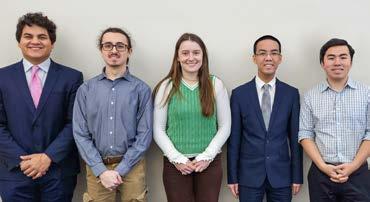
Kole Davis, Comp. Sci. & Comp. Thinking
Drew Bogdan, Computer Science
Kevin Dang, Computer Science
Vincent Do, Computer Science
Claire Yegian, Comp. Sci. & Comp. Thinking
Advisor: Jasmine Jans
DAB: Jesse Phillips
Sponsor: Fire Armada
Liaison: Michael Marzetta, Christy Marzetta & Levi Wilson
In the interest of informing the public about aerial firefighting, Fire Armada assigned the CS24-02 team with the task of developing a historical graphic simulation. The simulation depicts wildfires and the flights of large firefighting aircraft in the United States from 2020 through 2022. The project involved developing a web application that features an interactive map and timeline showcasing fires, flight paths of firefighting aircraft, and the locations of tanker bases used for loading fire retardant and refueling. Additionally, the application includes a dashboard that displays statistically-derived graphs and other insightful visualizations.

» Gonzaga School of Engineering & Applied Science
» » » » » » »
| | 4 |
CS24-03 | Power Line Protection System

» Cameron Chetcuti, Computer Science
» Adam Huonder, Computer Science
» Liam Navarre, Computer Science
» Peter Vahlberg, Computer Science
Advisor: Yanping Zhang
DAB: Russell Mann & J.J. Doria
Sponsor: Avista
Liaison: Gregory Johnson & Kevin Damron
Avista is a large electric utility company in the greater Spokane area. Avista has identified power line-related injuries as a major area of concern for safety. CS24-03 was tasked with developing a prototype automated detection system for linemen. The team used a lidar sensor to identify a power line and potential hazardous objects, and instantiated artificial boundaries of 10’ and 2’ 2”. The team’s system also needed to sound an alarm when either boundary is crossed, telling the user that they are in potential danger. After the team’s initial implementation of the product, it was tested at an Avista-sponsored site for accuracy, precision, and speed of performance. The team used this data to improve the app further.

CS24-04 | AI Filtering Tool

» AJ Wilson, Comp. Sci. & Comp. Thinking
» John Carnegie, Computer Science
» Dominic Orsi, Computer Science
» Samuel Sovi, Computer Science
Advisor: Cynthia Freeman
DAB: Dustin Cassell
Sponsor: Boeing
Liaison: Kalika Singh
Boeing tasked CS24-04 with scanning employee queries for intellectual property. Generative language models are becoming common tools for summarizing data and creating reports. However, data fed to these models is often unprotected; if used to train other AI generative text models, it creates concerns over privacy and use of data. The team’s project aimed to notify users of locations of text that should not be entered into generative models. CS24-04 experimented with numerous ways of detecting problematic text using various distance functions and clustering methodologies—common tools for data analysis. The team also developed a containerized application (one that is read-only so a computer system can’t change it) with an interactive user interface connected to a vectorized database and backend system.

Senior Design Expo 2024 |
5
CS24-05 TATS Data Model for a Digital Thread

» Jaylene Baltazar, Comp. Sci. & Comp. Thinking
» Maxwell Rettig, Comp. Sci. & Comp. Thinking
» Carolyn Bozin, Computer Science
» Nisa Meshal, Computer Science
Advisor: Alex Giacobbi
DAB: Kalika Singh
Sponsor: Boeing
Liaison: Kelli Howe
The CS24-05 team has been developing a solution to increase efficiency among shop floor workers at Boeing assembly factories. Workers are currently looking up time and temperature sensitive (TATS) data via a hardcopy with over 200 pages, and the team was tasked with creating a web application to provide quick access to the data. A data model has been reverse engineered from the given TATS data and uploaded to a database. The team developed a full stack web application, allowing workers to query the database for materials through a clean user interface using the known ID. The application has various features such as the ability to view comprehensive results, which ensures workers know the live status of every material and part they are using.

CS24-06 | Conference Room Scheduling App

» Darian Range, Comp. Sci. & Comp. Thinking
» Elizabeth Figueroa, Computer Science
» Cristal Meza, Computer Science
» Luke Nguyen, Computer Science
Advisor: Bethany Alcamo
DAB: Andrew Flagstead
Sponsor: 2Barrels
Liaison: Andrew Flagstead & Noah White
The CS24-06 team was tasked with developing a scheduling web application for employees to reserve conference rooms, desks, and other facilities in the Two Barrels’ offices. The application’s purpose is to organize room and desk availability to keep businesses organized and eliminate scheduling conflicts. The team’s approach included a frontend that was built using the Vue.js framework and a backend that was built using the Rails framework for obscuring and securing frontend requests and backend queries. Through this application, the team aimed to promote a more organized work environment, providing a user-friendly experience while maintaining the highest standards of security and efficiency.

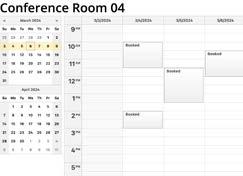
| Gonzaga School of Engineering & Applied Science
|
6
CS24-07 Rental Prediction System
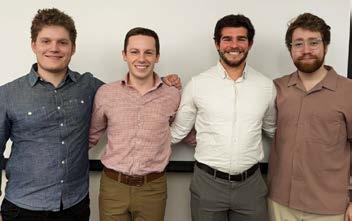
» Samuel Berkson, Comp. Sci. & Comp. Thinking
» Mason Manca, Comp. Sci. & Comp. Thinking
» Benjamin Puryear, Computer Science
» Evan Shoemaker, Computer Science
Advisor: Joe Dumoulin
DAB: Michael Tobias
Sponsor: Pangeon
Liaison: Graham Morehead
Immobiliare utilizes complex machine learning techniques to predict the sale price of a residential single-family home two years in the future. Using publicly available data from King County, Washington, the team built an Amazon Web Services-deployed service that allows users to navigate a map of King County and select or search properties to view. Users are able to view information about a property as well as the two-year price prediction. Sale prices are predicted using a combination of property-based data and economic data in a complex cellular automata model.
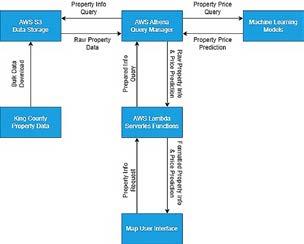
This model focuses on the relationships between a property and its neighbors, connecting data from surrounding properties to more-accurately mimic behaviors in the housing market.
CS24-08 | Strip Defect Detection

» Mathew Hasting, Comp. Sci. & Comp. Thinking
» Mackenzie Saunders, Comp. Sci. & Comp. Thinking
» Dennis Hu, Computer Science
» Michael Waight, Computer Science
Advisor: Chris Sharman
DAB: Jeb Kilfoyle
Sponsor: Kaiser Aluminum
Liaison: Jacob Patshkowski & Chris Nicol
CS24-08 has been working with Kaiser Aluminum to automate visual inspections on the production line, detecting defects in metal products as they exit the final stages of production. Using deep learning object detection models such as YOLOv6, the team has created a system which takes pictures of products live on the production line, analyzes them and marks any detected defects. Once a threshold is reached, the system sends a report to process engineers with the defect type and product ID for them to perform further inspection all in real-time. This allows Kaiser Aluminum to correct any errors in production immediately and saves products from being scrapped or repurposed.
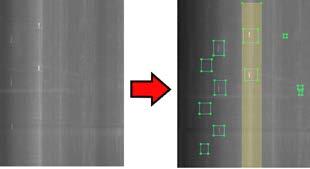
Senior Design Expo 2024 | |
7
CS24-09 Optical Character Reader

» Benjamin Berton, Comp. Sci. & Comp. Thinking
» Joshua Shetler, Comp. Sci. & Comp. Thinking
» Lida Chen, Computer Science
» Nathan Mautz, Computer Science
Advisor: Chris Sharman
Sponsor: Kaiser Aluminum
Liaison: Jacob Patshkowski & Chris Nicol
The CS24-09 team collaborated with Kaiser to enhance aluminum plate code verification. The team was tasked to supplement human verification with an optical character recognition (OCR) system. Facing challenges such as poor lighting conditions and reflections obscuring the code, the team shifted from a binary to a spectrum-based system, introducing confidence levels from 0 to 1. This change offered operators a nuanced understanding of verification results and allows the system to have useful results even when only part of the code can be read by the OCR. The implementation included a preprocessing system, a web interface, and a sophisticated OCR result interpretation system. Tailoring a pre-built OCR solution to Kaiser’s needs, the team effectively addressed challenges with lighting conditions, improving the verification process, and giving Kaiser a codebase that can be easily extended.

CS24-10 Device and Software Inventory Tool

» John Nealon, Comp. Sci. & Comp. Thinking
» Brandon Huyck, Computer Science
» Colleen Lemak, Computer Science
» Artis Nateephaisan, Computer Science
Advisor: Mike Mudge
DAB: Richard Weeks
Sponsor: Medcurity
Liaison: Rachel Kunkel
The CS24-10 team was tasked by Medcurity with creating an automated network inventory generation tool to assist in the performance of risk assessment analyses. Currently, Medcurity’s clients must do this manually, which can be difficult and lead to inaccurate results. To address this, the team developed a tool that crawls the client’s network, stores the software and devices it finds in a MySQL database, displays the data in a user interface (UI) connected to the database using HTML and PHP, and then allows the client to export the results to a CSV file. The user must login through the UI, verifying credentials against those securely stored in the database, and can then view and modify the data as well as launch the crawler and export script with a button click. After user acceptance testing with the sponsor, the team delivered all code developed to Medcurity.

| Gonzaga School of Engineering & Applied Science
| |
8
CS24-11 Language Translation Minigame

» Maalik Brown, Comp. Sci. & Comp. Thinking
» Connor Deide, Computer Science
» Peyton Langsdorf, Computer Science
» Marco Lazzarato, Computer Science
Advisor: Chris Sharman
Sponsor: Gravity Jack
Liaison: Luke Richey, Chris Adam & Adam Lutz
Gravity Jack has been developing a new mobile game, “Wartribe of Binyamin,” aiming to combine Augmented Reality elements with the power of AI. CS24-11 was asked to aid in the development of this game by creating a mobile application consisting of one key feature present within the larger game: the Portal Feature. The game wants users to interact with each other, and one way to accomplish this is by using a portal to visit friends in their ‘Home Base’ or some preset location. Using the Unity Game Engine, the team has created an application that allows users to deploy and interact with a portal through their mobile device in an XR space. The app utilizes OAuth 2.0 to perform Sign-In through Google and Google’s Firebase service as a cloud backend solution.

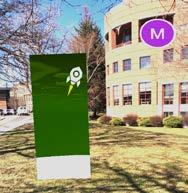
| CS24-12 Bank Fee Analytics System

» Michael Bernard, Computer Science
» Zachary Burge, Computer Science
» Colton Elfstrom, Computer Science
» Graham Sabin, Computer Science
Advisor: Pete Messina
DAB: James Stevenson
Sponsor: Treasury4
Liaison: Randie Douse, Mistie Jessen, Ed Barrie & Eli Brunette
Treasury4 has various modules which enable finance teams to turn data into actionable insights. CS24-12 was tasked with creating the Bank Fee Analytics (BFA) tool for the Cash4 module. This tool aims to track bank fees for companies across many different banks and bank accounts. The team has created an end-to-end solution for Treasury4 customers to see analytics about their bank fees. This solution starts with an account analysis statement upload and ends with PowerBI dashboards being displayed to the customer. The Bank Fee Analytics tool requires continuous development from Treasury4, and CS24-12 has written clear documentation to hand this project over to Treasury4.

Senior Design Expo 2024 |
|
9
CS24-13 Smartphone Spectrum Viewer

» Carson McDermott, Comp. Sci. & Comp. Thinking
» Katie Imhof, Computer Science
» Jonathan Smoley, Computer Science
» John Stirrat, Computer Science
Advisor: Pete Messina
DAB: Michael Herzog
Sponsor: Itron
Liaison: Jon Smitham & Joel Eddy
CS24-13 collaborated with Itron to tackle the challenge of visualizing endpoint signal strength across radio frequency (RF) channels used by smart meters. In response to Itron’s need for a portable, multi-platform solution, the team developed an application using the cross-platform framework called React Native. The team’s solution connects to the Itron Mobile Radio (IMR) for precise RF packet capture while presenting a graphical display of channel activity. The application also allows users to customize the spectral view by adjusting labels, scaling and appearance of signal strength indicators. The collaborative effort aims to provide Itron with a flexible tool for visualizing and managing endpoint signal strength efficiently, catering to Windows, Android, and eventually iOS platforms.

CS24-14 Embedded IoT Protocols

» Jesse Adams, Computer Science
» Danni Du, Computer Science
» Yu Yu Kao, Computer Science
» Sean Burke, Computer Science
Advisor: Phillip Fishburn
DAB: Ryan Floyd
Sponsor: Itron
Liaison: Bob Strasser & Daric Sage
Itron produces solutions for cities to manage critical infrastructure such as power and water utilities. CS24-14 was tasked with developing an endpoint, using technology to more effectively manage city utilities. This endpoint can send utility data to a server, with a heavy focus on low power consumption. Itron guarantees long-term support, so the endpoint must be able to work in the field without replacement for 20 years. The team developed an IoT transmission protocol for this endpoint to send and receive data for smart utility meters with a focus on low power consumption. The team also created extensive documentation on the work, enabling Itron’s team to easily continue development on this project.
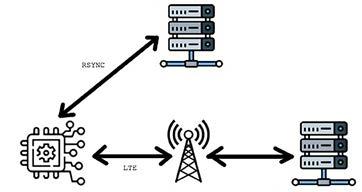
| Gonzaga School of Engineering & Applied Science
| | 10
Upriver Dam Break Evaluation
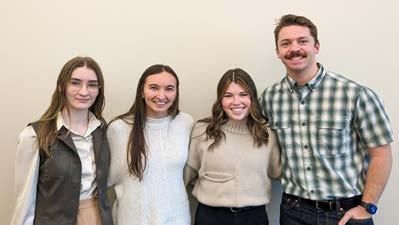
» Esme Nelson, Civil Engineering
» Grace Luoma, Civil Engineering
» Chelsea Le, Civil Engineering
» Jack Hunter, Civil Engineering
Advisor: Ben Cary
DAB: Kaela Mansfield, Dawson Matthews & Kayla Kassa
Sponsor: City of Spokane
Liaison: Jeanne Finger & Seth McIntosh
EN24-20 was asked to support the City of Spokane to reevaluate the classification of the Upriver Dam (currently high hazard) given by the Federal Energy Regulatory Commission (FERC). The team updated the existing hydraulic model with new terrain data, calculated breach parameters, and added an in-line 2-dimensional area around the Upriver Dam. The updated hydraulic model was then used to compute a dam breach analysis. Deliverables included the updated hydraulic model, breach inundation maps, tabular output data, and a final report detailing methods and results. Using all the comprehensive data gathered from the analysis, the Team presented a recommended hazard classification to the city.

EN24-21 Drinking Water System Resilience to Wildfires

» Pablo Gomez, Engineering Management
» Adam Chin, Civil Engineering
» Matt Foley, Civil Engineering
» Noah Hoefer, Civil Engineering
» Mark Chayka, Civil Engineering
Advisor: Kyle Shimabuku
DAB: Andrew Matsumoto, Katie Larimer & Dave Duncan
Sponsor: GU/MSU
Liaison: Amanda Hohner
The ENSC 24-21 team engaged in the beginning of a five-year research program funded by the U.S. Forest Service evaluating drinking water system challenges and costs for wildfire preparedness in the Western US. They assessed and confirmed the effectiveness of the Eugene water treatment plant post-wildfire impacts, investigated wildfire impacts on treatment processes, and proposed mitigation strategies for water distribution system contamination. The team developed effective testing methodologies and contributed to initial data collection for how to treat wildfire-impacted waters and manage water distribution system contamination.

Senior Design Expo 2024 | EN24-20 | |
11
Bringing Netherland’s Sustainable Practices to GU

» Jack Wilson, Engineering Management
» Joie Reyes, Civil Engineering
» Thomas Roth, Civil Engineering
» Alex Macias, Civil Engineering
Advisor: Sue Niezgoda
DAB: Annikki Chamberlain, Bri Dorie, Adam Hutchinson & Alex Maxwell
Sponsor: Gonzaga University
Liaison: Tomson Spink
In the summer of 2022, all members of the team traveled to Delft, Netherlands to study sustainable cities alongside GU Civil Engineering faculty. After their return, Gonzaga tasked EN24-22 with determining solutions to help the campus reach the goals outlined in the Spokane Sustainability Action Plan and the Gonzaga Climate Action Plan. Through reviewing these plans the team identified three areas of focus: transportation, water management, and buildings & energy. The team performed a comprehensive existing conditions study to identify problems in the focus areas on campus that would benefit from implementing sustainable design practices from the Netherlands. EN2422 developed a conceptual design for the North Astor Street and Cataldo Way corridor that demonstrates stormwater infiltration basins, green facades, and bicycle and pedestrian priority streets.

EN24-23 | Arlington Municipal Airport Taxiway Reconstruction

» Robby Brodar, Civil Engineering
» Shawn Crowell, Civil Engineering
» James Kem, Civil Engineering
» Alexi Townsend, Civil Engineering
Advisor: Adam Miles
DAB: Lindsay Gilbert, Stu Barton, Rebecca O’Sullivan & Bob Turner
Sponsor: DOWL
Liaison: Megan Zollars
DOWL has tasked EN24-23 with redesigning taxiway A1 and A4 at the Arlington Municipal Airport in Arlington, Washington. The current taxiways have ‘expansive pavement’, which refers to section of the taxiway in which two planes can fit side by side. To allow larger aircraft to use the airport, DOWL asked that the designs conform to FAA Taxiway Design Group 3.EN24-23 developed two concept designs per taxiway (each with a holding bay option) for a total of four concepts for each taxiway. A design workshop was completed with Arlington Municipal airport and the two optimal concepts chosen were 90-degree turns without a holding bay. EN2423 then completed a preliminary design which included a Construction Safety Phasing Plan, erosion/sediment control plan, typical section, lighting/signing/marking plan, marking details, and a construction cost estimate for each taxiway.

EN24-22 | Gonzaga School of Engineering & Applied Science
|
12
EN24-24 Trent Bridge Replacement and Construction

» Weston Vaughn, Civil Engineering
» Demetrius Padilla, Civil Engineering
» Matteo Schulz, Civil Engineering
Advisor: Erik Wick
DAB: Vince Poxleitner & Kyle Umlauf
Sponsor: Garco/WSDOT
The East Trent Avenue Bridge spans the Spokane River just east of Hamilton Street and east of downtown Spokane. Garco Construction was awarded the contract to remove the five-span concrete arch bridge constructed in 1910 and replace it with a four-span bridge. Garco tasked EN24-24 with designing a safe and effective formwork system for constructing one concrete column, one concrete pier cap, and one span of the bridge deck overhang system. The design considers cost, safety, and time efficiency for Garco. The ENSC-24 team has provided Garco with 11”x17” plan set drawings of the formwork systems with sufficient time for review by the project owner, Washington State Department of Transportation. The team followed and referenced WSDOT’s specifications to guide the design approach and methods of submittals.
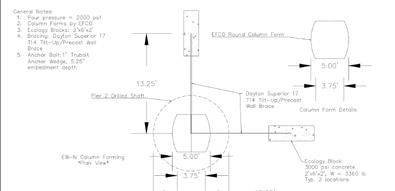
EN24-25 | Stormwater Quality Improvement Study

» Brynna Bone, Civil Engineering
» Maeve Patterson, Civil Engineering
» Audrey Stevenson, Civil Engineering
» Sarah Simmons, Civil Engineering
Advisor: Aimee Navickis-Brasch & David Moss
DAB: Glorilyn Maw & Colleen Little
Sponsor: City of Spokane
Liaison: Lorena Croucher
The City of Spokane is retrofitting stormwater basins with best management practices (BMPs) to capture and treat stormwater. EN24-25 was tasked with prioritizing a stormwater basin for retrofit and to design BMPs. The team determined the criteria to use in evaluating three basins in Northwest Spokane—Rifle Club, Hollywood, and Kiernan Basin. The criteria were organized into a weighted matrix. The team recommended that Rifle Club as the priority basin and designed four different BMPs to present to the City: Rain Gardens, Non-Vegetated Bio-Infiltration, Grass Swales, and Stormwater Planters. Each design is adaptable to various locations in the basin and includes information on cost, construction, operation and maintenance requirements.
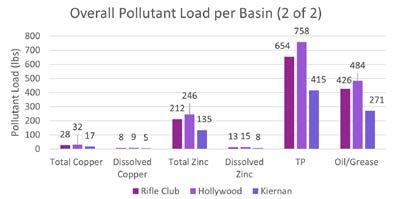
Senior Design Expo 2024 |
|
13
EN24-26 |
Wrong Way
Driving Design Review of I-90 in Spokane
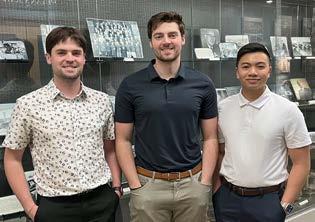
» Tim Mansker, Civil Engineering
» Rylan Mananquil, Civil Engineering
» Marco Scarsella, Civil Engineering
Advisor: Glenn Blackwelder
DAB: Jennifer Emerson-Martin, Karie Gullickson & Jay Hassell
Sponsor: Horrocks Engineers
Wrong-way driving (WWD) on highways, although infrequent, can lead to severe and fatal crashes. These crashes often not only involve the wrong-way driver but also other road users who have made no driving errors. Such incidents are not merely reflections of driver error but suggest there may be potential improvements to the road system. To address this, the EN24-26 team, with Horrocks Engineers, conducted a WWD design review of I-90 from Four Lakes to Stateline. This included thorough analyses of crash data and off-ramp conditions, with research on design codes, social impact, and existing solutions ranging from reflective tape to Intelligent Transportation Systems. The result was a contractor task order with itemized countermeasures submitted to the local jurisdictions for implementation. These countermeasures were cost-effective without compromising their expected effectiveness.

EN24-27 Fire Training Facility Structural Design

» Matt Johnson, Civil Engineering
» Taylor Auerbach, Civil Engineering
» Matthew Hoffman, Civil Engineering
Advisor: Ted Bernards
DAB: Emily Sackmann & TJ Bolser
Sponsor: Coffman Engineers
Liaison: Damiano Seghetti
The Spokane Valley Fire Department (SVFD) is served by a 32-year-old, 2,000 sq. ft. training classroom with two offices, two bathrooms and one shower. With an increase of staffing from 80 to 234 personnel over the last 30 years, the current training facility is vastly inadequate to accommodate the growth and changing training requirements. SVFD is constructing a new training facility with more classrooms and offices as well as an apparatus bay. EN24-27 was tasked with designing the gravity and lateral force resisting systems for the new training facility. The team developed gravity and lateral loads per ASCE 7-22, structural plan sets including framing and foundation plans, and compiled the analysis into a calculation book.

| Gonzaga School of Engineering & Applied Science
|
14
EN24-28 |
East Silver Creek Bridge Design

» Ben Trigg, Civil Engineering
» Will Newhoff, Civil Engineering
» Logan Fay, Civil Engineering
Advisor: Kevin Cary
DAB: Melissa Verwest & Damiano Seghetti
Sponsor: Coffman Engineers
The East Silver Creek Bridge, located in Ferry County, WA, sees roughly 445 average daily traffic (Pyun, 2018) and is owned by the County Highway Agency. The bridge has been posted for a 5-ton weight limit due to poor structure conditions. The bridge requires repair and needs to undergo reconstruction. The team considered three bridge alternatives and developed a decision matrix for evaluation, including sustainability of materials, social sustainability, construction time, and construction cost. The team chose conventional prestressed girders with a cast-in-place concrete deck as the best option and further developed the bridge design. The substructure will consist of concrete abutments at each side with each having six concrete-filled circular steel piles driven 45’ deep. This project aims to take the reconstruction of the East Silver Creek Bridge to 30% design.

EN24-40 Fire Extinguishing System Detection & Control
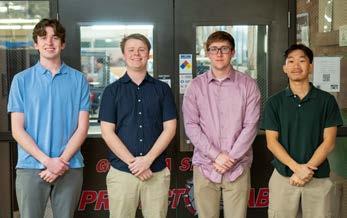
» Bret Robert, Engineering Management
» Ethan Osgood, Computer Engineering
» Hayato Tsujii, Computer Engineering
» Connor Lindahl, Electrical Engineering
Advisor: Meirong Zhang
DAB: Brent Barr
Sponsor: City of Spokane
Liaison: Chris Averyt & Foster Newberg
EN24-40 was tasked with developing a prototype for an automated extinguishing system for fires that break out on the tipping floor of the Spokane Waste to Energy facility. The team equipped the physical fire extinguisher with the hardware, programming, and wiring necessary to detect and locate fires in addition to providing manual and automated control options for the extinguisher. Knowing that fires on the tipping floor are commonly caused by lithium-ion batteries and burn at temperatures over 2000 degrees, the team worked to isolate and calculate the explicit coordinates of fires in places where vehicle exhaust and people may be visible. In addition, the team equipped the system with a display showing a thermographic view of the tipping floor as well as an automated targeting algorithm to extinguish the industrial grade fires while preventing them from spreading.

Senior Design Expo 2024 |
|
15
EN24-41 |
Dental Composite Dispenser
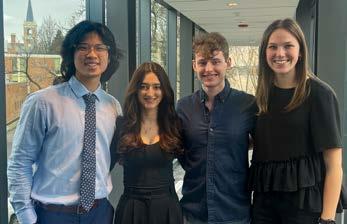
» Elizabeth Brands, Mechanical Engineering
» Lillian Hong, Mechanical Engineering
» Quinn Donnelly, Electrical Engineering
» Cameron Zheng, Computer Engineering
Advisor: Shane Pacini
DAB: Scott Schwartz
Sponsor: David Welton, DDS
Dental composite dispensers play a pivotal role in contemporary dentistry, providing a means of precise application of light-cured dental composite onto teeth. The typical spring-loaded dental composite dispenser has remained the industry standard mainly due to its simplistic and inexpensive design, but does not have any built-in features that assist flow of the composite or moldability for the user. Team EN24-41 worked with David Welton, D.D.S., to increase the flow of the composite using two primary techniques, heating and vibration, paired with automated extrusion. This puts all the features lacking from the typical dental composite dispenser into a cohesive, linear, automated pen-shaped design.

EN24-42
Lateral Reinstatement System

» Trevor Cross, Mechanical Engineering
» Jack Murray, Mechanical Engineering
» Joseph Macauley, Computer Engineering
» Matthew VonWahlde, Computer Engineering
» Nathaniel Bartlett, Electrical Engineering
Advisor: Sam Shoemaker
DAB: Justin Chin
Sponsor: Michels Trenchless
Liaison: Tucker Toelke
Michels Trenchless Inc. commonly uses Cured-in-Place Pipe (CIPP) for underground pipe rehabilitation. This process works by expanding an impregnated liner within the deteriorating pipe, expanding it to conform to the existing pipe surface, then curing the liner with UV or heat, leaving behind a new smooth pipe wall. One issue that arises when using CIPP is that any laterals, tees, or branches that intersect with the pipe being rehabilitated are blocked by the newly installed liner. ENSC-42 was tasked with developing a new method to detect and mark the locations of these hidden laterals. The team developed an electromagnetic sensor which utilizes high frequency waves to determine the reflection coefficient of the pipe and its surroundings. When the sensor is on top of a hidden lateral, the reflection coefficient experiences a drop in magnitude, signaling that a lateral is present.

| Gonzaga School of Engineering & Applied Science
|
16

» Amelia Ellis, Computer Engineering
» Ian Flury, Computer Engineering
» Emmett Crawford, Computer Engineering
» Mark Madler, Computer Engineering
Advisor: Shane Pacini
DAB: Terra Donley
Sponsor: GU Human Physiology
Liaison: Janet Zhang-Lea
Gonzaga Human Physiology undergraduate students use ultrasound technology as a tool for their research, and the department requested a method for students to repeatably recreate ultrasound scans with minimal training. EN24-43 was tasked with designing a system that leverages Inertial Measurement Unit (IMU) technology to localize the position and orientation of the ultrasound probe in space and record that data so the scan could be recreated at a future time. EN24-43 designed a software application and a robust test fixture to validate the effectiveness of the design before finally deploying the solution to research students in the lab, where they used the technology to monitor an athlete’s Achilles Tendon under various stresses.
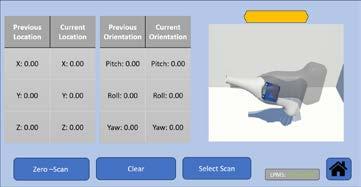
EN24-44 Concert for the Deaf
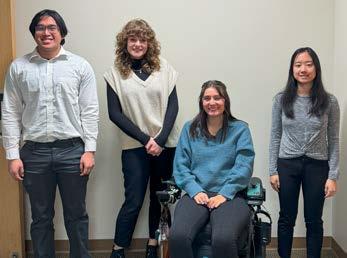
» Allison McKernan, Engineering Management
» Haley Crabbe, Engineering Management
» Christine Cabero, Computer Engineering
» Gabriel Matthew Manila, Electrical Engineering
Advisor: John Tadrous
DAB: Kaitlyn Helsing
Sponsor: Phillip Pintor
Too frequently, products and experiences are created for able bodied people that leave out entire groups who have every right to live lives that are as enriched as everyone else’s. This problem is extremely prevalent in the music industry. Concerts have the potential to be an incredible experience, with or without their auditory aspects. With the goal of making concerts a more valuable experience for the deaf and hard of hearing, the team is creating a set of devices that attach to musical instruments to create a live visual display of auditory performances. When musicians using these devices play their instruments, the devices will pick up on the frequencies being played and respond by displaying colorful lights to match at brightness levels that respond to the instrument’s volume levels. These devices, when used as a group, will transform music into a show of lights.


Senior Design Expo 2024 |
| |
EN24-43
3D Ultrasound Processing
17
EN24-45 Plumbing Insulation Tech Integration
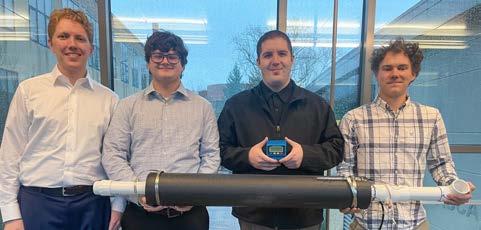
» Christopher Knight, Mechanical Engineering
» William Reebs, Mechanical Engineering
» Chance Wilson, Computer Engineering
» Ryan Beck, Computer Engineering
Advisor: Kevin Damron
DAB: Duane Radmer
Sponsor: Dragon Jacket
Liaison: Todd Peretti & Matt Nichols
Dragon Jacket specializes in the design and manufacture of modular insulation solutions for industrial piping and storage tanks, employing a polyurea spray coating to envelop their foam insulation, resulting in a rigid system. ENSC24-45 was charged with the task of incorporating sensors and heating control into a new insulation prototype. This prototype harnesses embedded resistive wire for heating, maintaining modularity by situating all components above the polyurea layer, avoiding direct contact with the pipe. Three insulation prototypes were developed, constructed, and evaluated, featuring integrated temperature sensing, flow sensing, heating control, and lighting. Additionally, a PLC test system was established to simulate the control systems utilized by Dragon Jacket’s clientele. An HMI program was also created, enabling real-time data logging from the PLC.
|
EN24-46 Helical Antenna Array Evolution

» Aidan Smith, Mechanical Engineering
» Pierce Thompson, Mechanical Engineering
» Hoang Nguyen, Electrical Engineering
» Matthew Auble, Electrical Engineering
» Benjamin Powers, Electrical Engineering
Advisor: Steve Schennum & Bob Conley
Sponsor: GU SARL

In partnership with the Gonzaga Smart Antenna Radio Laboratory (SARL), the ENSC-46 team designed a helical antenna capable of operating at ISM band frequencies. The design followed the results of prior work to create a center-fed, multi-element array with circularly polarized radiating petals, allowing combinations of right and left hand circularly polarized elements to use any possible polarization in an omnidirectional pattern. Prototypes were designed, simulated, fabricated, assembled, and tested entirely in house, developing practical skills by providing hands-on training. The team achieved a measured S11 return loss of –21.67dB at 902 MHz compared to the model simulation at –21.28 dB at 909 MHz. An S11 of -10 dB over the target percent bandwidth of the antenna was also achieved, and the desired gain pattern was successfully replicated.
| Gonzaga School of Engineering & Applied Science
|
18
EN24-50 Fire Extinguishing System Mechanical Design

» Connor Hartman, Mechanical Engineering
» Nathan Omodt, Mechanical Engineering
» Jose Reyes Bolanos, Mechanical Engineering
» Kristopher Serrano, Mechanical Engineering
Advisor: Damon Taam
DAB: Doug Pooler
Sponsor: City of Spokane
Liaison: Chris Averyt & Foster Newberg
The Spokane Waste to Energy Plant plays a vital role in both waste disposal and energy generation. Despite its importance, managing hazardous household materials presents fire risks, jeopardizing workers and community safety. Current fire suppression methods have limitations in targeting specific sources, especially on the tipping floor where fires can rapidly escalate. To tackle this issue, a project launched earlier at Gonzaga aimed to develop an automated fire-extinguishing system, reducing the reliance on manual intervention. The initial prototype achieved a 60ft stream range, but for the 20232024 project, interdisciplinary teams in mechanical and computer science collaborated to enhance automation, environmental safeguards, and integration into the plant. The goal is to deliver a robust, safe solution for fire control without sacrificing operational efficiency.

| EN24-51 Aircraft Float Manufacturing Redesign

» Christopher Connor, Engineering Management
» Natalie Firth, Mechanical Engineering
» Colin Pottinger, Engineering Management
» Greta Tauferner, Mechanical Engineering
Advisor: Gabe Achenbach
DAB: Roy Wortman & Wayne Johnson
Sponsor: Edo Floats
Liaison: Todd Banks & Hunter Banks
Edo Aircraft seaplanes have a rich history dating back to 1930, with the Kenmore Aircraft Company subsequently assuming a leading role in advancing and innovating these aircraft. Given the longstanding presence of these seaplanes in the aviation industry, the traditional manufacturing process has been characterized by extensive labor and the
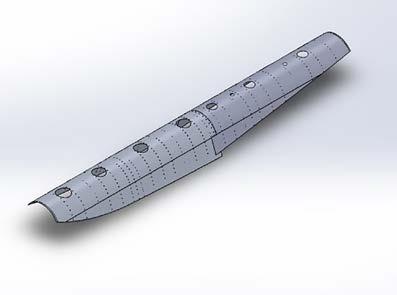
|
19
EN24-52 Rover Challenge Arm & Gripper
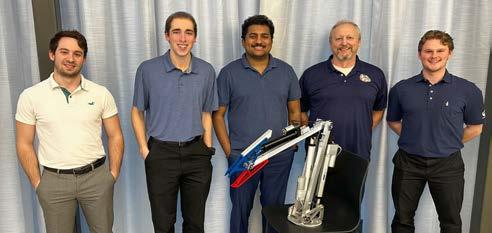
» Jeffrey Henion, Mechanical Engineering
» Thomas Selfridge, Mechanical Engineering
» Joel Vincent, Computer Engineering
» Jonathan Nastasi, Computer Engineering
Advisor: Tim Ecklund
DAB: Eric Ryan
Sponsor: Gonzaga Robotics
Liaison: Jeffrey Henion
Gonzaga University Robotics Team is building a Mars rover to compete in the University Rover Challenge. Senior design team EN24-52 is building a robotic arm to enable the rover to have an intuitive way to interact with the competition environment. The primary goals for the arm are to perform multifaceted tasks such as lifting 5kg, typing on a keyboard, manipulating objects such as a USB drive, and employing tools like a hex screwdriver. The entire arm’s operation will be under manual control assisted by inverse kinematics. The team has completed the design, manufacturing, and electronic control for the main arm assembly responsible for larger object manipulation. A significant effort has been made to ensure the robotic arm is physically, electronically, and code compatible with the rover to be a drop-in module.
| EN24-53 High-Flow Fuel Transfer System
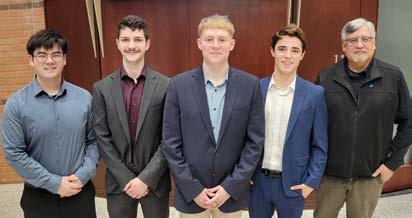
» Preston Ernst, Mechanical Engineering
» Cameron O’Kelley, Mechanical Engineering
» Austen Schunk, Mechanical Engineering
» William Wenstrand, Mechanical Engineering
Advisor: Phil Pintor
DAB: Skye Aldrich
Sponsor: Tatitlek Technologies, Inc
Liaison: TSgt Joseph Young, Capt Friedrich Martin, MSgt Donald Lehman & SMSgt Seth Runyon
Team EN24-53 is collaborating with Tatitlek Technologies, Inc. to enhance the efficiency of fuel transfers between aircraft and containers. This partnership aims to create a mobile, easily deployable pumping system capable of significantly increasing the current system’s fuel-transfer rate of 200-300 GPM. The goal is to boost this capacity by 200%-300%, while maintaining a compact and tactical form which can be deployed from Department of Defense assets operating in dynamic locations. This project team has completed the system’s design, including drawings, CAD models, a comprehensive bill of materials, and a thorough structural and fluid analysis to ensure that the design achieves the desired flow rate.
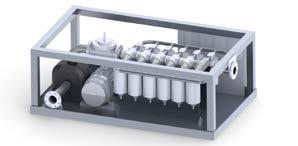
| Gonzaga School of Engineering & Applied Science
|
20
EN24-54 Metallic Seal Stretch-Former

» Adam Bussey, Mechanical Engineering
» Dominic Kelso, Engineering Management
» Nicholas Linthacum, Computer Engineering
» Carson Free, Computer Engineering
Advisor: Gary Weber
DAB: Lee Firth, Jared Marshall & Brandon Sargent
Sponsor: Jetseal
Liaison: Steve Hudlet & Jim Mundy
Jetseal produces metal seals used primarily in the aerospace and nuclear industries. These seals are formed into noncircular shapes from circular blanks. Current methods are labor-intensive and prone to human error. EN24-54 has been tasked with creating a semi-automated machine that forms those non-circular seals repeatedly. The team created a prototype that is driven by a stepper motor with a lead screw on an aluminum track frame. It is controlled through a Raspberry Pi and Programmable Logic Controller (PLC). The design is being finalized into a more robust, full-scale prototype constructed from a steel tube frame along with a fully functional user interface for simple use in Jetseal’s facility.

| EN24-55 Sustainable Seat Cushion

» Olivia Goodman, Mechanical Engineering
» Emrie Langfeldt, Mechanical Engineering
» Nicholas Tudor, Mechanical Engineering
Advisor: Bob Reed
DAB: Karen Hills
Sponsor: Boeing
Liaison: Derrick Pruitt & Alec Dehnert
EN24-55 has worked to decrease carbon emissions and improve sustainability in the aviation industry for Boeing through developing a more sustainable airplane seat cushion. The team analyzed the current seat configuration and proposed suitable alternatives with various advantages. The redesigned seat cushion involves utilizing a sustainably sourced upholstery material, IZIT XRT Faux leather, and a new foam material, Octaspring. Each material provides a reduction in weight, reducing carbon emissions by decreasing fuel consumption. Alongside Kaas Tailored and Adient Aerospace, the team developed prototype cushions. These were subjected to comfortability testing and pressure mapping to qualify the cushions for passenger comfort, and oil burn testing to ensure the proposed design meets FAA regulations and safety requirements.
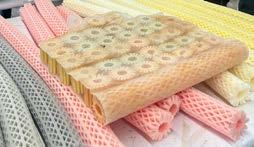
Senior Design Expo 2024 |
|
21
EN24-56 Aircraft Interior Parts Recycling
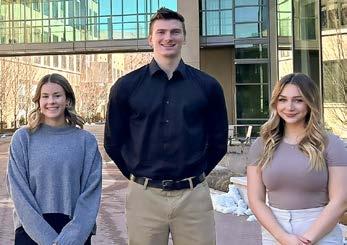
» Elizabeth Anders, Mechanical Engineering
» Stephen Devine, Mechanical Engineering
» Faith Duberow, Mechanical Engineering
Advisor: Harman Khare
DAB: Brenna Doll
Sponsor: Boeing
Liaison: Karen Hills
EN24-57
Approximately 90% of an aircraft is completely recyclable at the end of service life. Boeing tasked the EN24-56 team with conducting an industry-wide survey to track the waste streams of the remaining 10%, which is primarily made up of interior parts. After performing the survey, the team chose to focus on alternatives for a large contributor to waste: the interior sidewall panel. The team performed a material analysis on a disassembled Boeing sidewall panel and chose a material replacement for the panel’s body. The team also considered corresponding manufacturing processes. A business case presented the positive environmental impacts of implementing these changes along with an overall cost analysis.

Electric Wing Deicing

» Benjamin Connors, Mechanical Engineering
» Erik Dorgan, Mechanical Engineering
» Caleb Engelken, Mechanical Engineering
» Jack Morris, Mechanical Engineering
Advisor: Andy Johnston
DAB: Karly McCauley
Sponsor: Boeing
Liaison: Richard Loftis & Edwin Smith
Traditionally, airplane deicing is reliant on expensive and environmentally harmful glycol-based fluids. Boeing is interested in finding a better solution. As a part of this effort, team EN24-57 is carrying on a project from last year which includes designing and testing a thermal emitter embedded within the composite wing structure. By integrating thermal emitters into the wing structure, the project aims to streamline deicing processes, mitigate the need for glycol, and improve cost-effectiveness. Leveraging and improving on the previous team’s research, team EN24-57 refined the design via thermal finite element analysis and manufactured the design into a prototype. With the prototype, the team was able to simulate the icy wind conditions and get real world data to support their theoretical testing.

| Gonzaga School of Engineering & Applied Science
| |
22
EN24-58 Fastener Push In vs. Rivet Gun Installation II
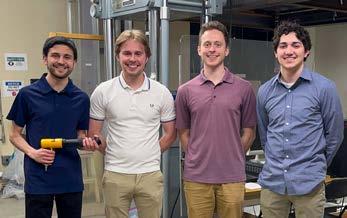
» Sean Essad, Mechanical Engineering
» Santiago Mejia Forero, Mechanical Engineering
» Dylan Roylance, Mechanical Engineering
» Liam Schamhart, Mechanical Engineering
Advisor: Chris Nicol
DAB: Nick Questad
Sponsor: Boeing
Liaison: Nick Reasoner, Monica Brockway & Tanni Sisco
EN24-58 has been tasked by Boeing to design a predictive model for the forces experienced on structures resulting from two methods for installing bolts: a push-in method and the rivet gun method. Push-in represents a laboratory developmental setting where a constant force is used to insert a bolt. The rivet gun is a nonconstant method that requires multiple pneumatic blows to insert a bolt. The team developed two models of testing for each method. The push-in method developed by the previous year’s team was improved on, and the rivet gun method was developed this year. The rivet gun method involved building a force structure using load cells, Excel, and MATLAB to collect the force produced by the rivet gun. The team then searched for correlations in the data.

| EN24-59 Universal Personal Flotation Device

» Rielyn Domingo, Mechanical Engineering
» Audrey Gratzer, Mechanical Engineering
» Maggie Majhanovich, Mechanical Engineering
Advisor: Andrew Asper
DAB: Les Bohush
Sponsor: Orebaugh Enterprises
Liaison: Chad Orebaugh
The EN24-59 team engaged with Chad Orebaugh, the sponsor, to address the need for a universal personal flotation device. This combines three types of life jackets outlined by the US Coast Guard. The team is creating a new flotation device that is lighter, thinner, and more buoyant than life jackets seen on the current market. EN24-59 is tasked with designing and developing a universal life jacket prototype. The team completed the project by producing design drawings and having a sewing contractor build two prototypes: one for the sponsor and one for the team.


Senior Design Expo 2024 |
|
23
EN24-60 Scrap Tub Redesign

» Alec Harris, Mechanical Engineering
» Judson Hayes, Mechanical Engineering
» Miles Young, Mechanical Engineering
Advisor: Colleen Nolting
DAB: Dillon Turnbull
Sponsor: Kaiser Aluminum
Liaison: Kendall Hills & Chris Nicol
Kaiser Aluminum is an aluminum stock manufacturer and throughout their facilities, large metal tubs are used to store scrap pieces for recycling. ENSC24-60 was tasked with developing an improved scrap tub design that hit major key components: increased strength and durability plus decreased cost and weight. Tubs must be stackable and able to be moved via forklift. The team developed a design that no longer has feet, but instead has a pallet-like base with ½” thick rectangular tubes for the forks to enter. The team used ANSYS to help predict if the new concepts could handle the expected forces. Alignment ears were added to the top brim of the tubs to prevent stacked tubs from sliding off one another and a testing plan was completed. A full-scale prototype was made to test the new designs.

EN24-61 Modular Chlorine Gas Controller

» Joseph Berbach, Mechanical Engineering
» Chance Nishimura, Mechanical Engineering
» Olivia Schaefer, Mechanical Engineering
Advisor: Jeff Nolting
DAB: Philip Pintor
Sponsor: Kaiser Aluminum
Liaison: David Fenstad & Chris Nicol
Kaiser Aluminum’s Trentwood facility casts aluminum ingots that are rolled into plates and sheets. During the casting process, chlorine is injected into the molten aluminum to remove impurities. The control cabinets for the chlorine gas experience periodic failures that cause lost production while maintenance troubleshoots and repairs the equipment. Team EN24-61 was tasked with redesigning the chlorine control cabinet to make the design universal, working for both plate and sheet configurations. The cabinet also needed to be modular so the internal components can be removed, taken off-site for maintenance, and replaced with a working unit. The team developed a new design and delivered a drawing package including 3D models, a piping and instrumentation diagram and engineering drawings of the cabinet interior.

| Gonzaga School of Engineering & Applied Science
| |
24
EN24-62 Multi-Station Wear Tester

» Joshua Keegan, Mechanical Engineering
» Alexander Trigloff, Engineering Management
» Preston Waid, Mechanical Engineering
Advisor: Harman Khare
DAB: James Weston
Sponsor: Gonzaga Department of Mechanical Engineering
The EN24-62 team was tasked with designing and fabricating a multi-station wear test apparatus (‘tribometer’) for use in the Gonzaga University Tribology Laboratory. The “Big Mack’s” unique properties include the 4 individual stack-like test stations. Each stack can test a unique material with up to 250N of force for a minimum test duration of 48 hours. All parts were made in-house excluding the pneumatic thrusters used for load application, and the motor for driving the reciprocating table. Live force readings are available from the fabricated S-type load cells on each stack. The main goals of this project were to maintain the size of the current tribometers in the lab, maintain rigidity, and improve access to test specimens. The results of the project include improved manufacturability, design, and use of space.

| EN24-70 West Seattle Bridge

» Holly Bice, Engineering Management
» Alexis Ewing, Engineering Management
» Amelia Hornbeck, Engineering Management
» Angela Roesler, Engineering Management
Advisor: Dannielle Haraldson & Melissa Verwest
DAB: Byrl Williams
Sponsor: Gonzaga Department of Engineering Management
Liaison: Gary Weber
The West Seattle Bridge, built in 1984. services over 100,000 vehicles daily. In March 2020, it was closed due to concrete crack growth in the main span box girders. EN24-70 was tasked with exploring the probable causes of this cracking, determining the best solution to restore the usage of the bridge, and developing a concept analysis of the solution. The team conducted literature reviews and a failure analysis to investigate the factors that led to the cracking. Concurrently, EN24-70 performed a Business Case Study and Design Assessment to evaluate the cost, time, and scope of two alternatives, repair or replace. This analysis led to the selection of a post-tensioned repair to the affected area. The team researched code requirements to develop the necessary capacity through load determination. EN24-70 also explored material sustainability through Environmental Product Declarations.


Senior Design Expo 2024 |
|
25
PRESENTATIONS | Computer Science
Bollier 003 Proctor: Chris Sharman
3:10 PM CS24-09 Optical Character Reader
3:40 PM CS24-08 Strip Defect Detection
4:10 PM CS24-02 Wildfire Resource Simulator
4:40 PM CS24-11 Language Translation Minigame
Herak 237 Proctor: Yanping Zhang
3:10 PM CS24-04 AI Filtering Tool
3:40 PM CS24-05 TATS Data Model for a Digital Thread
4:10 PM CS24-03 Power Line Protection System
Bollier 005 Proctor: Dan Olivares
3:10 PM CS24-07 Rental Prediction System
3:40 PM CS24-10 Device and Software Inventory Tool
4:10 PM CS24-13 Smartphone Spectrum Viewer
4:40 PM CS24-12 Bank Fee Analytics System
Paccar 007 Proctor: Luke Johnson
3:10 PM CS24-14 Embedded IoT Protocols
3:40 PM CS24-01 Boxy Software Development
4:10 PM CS24-06 Conference Room Scheduling App
PRESENTATIONS | Civil Engineering
Paccar 105 Proctor: Mark Muszynski
3:10 PM EN24-24 Trent Bridge Replacement and Construction
3:40 PM EN24-70 West Seattle Bridge
4:10 PM EN24-27 Fire Training Facility Structural Design
4:40 PM EN24-28 East Silver Creek Bridge Design
Bollier 120 Proctor: Sue Niezgoda
3:10 PM EN24-20 Upriver Dam Break Evaluation
3:40 PM EN24-21 Drinking Water System Resilience
4:10 PM EN24-25 Stormwater Quality Improvement Study
4:40 PM EN24-22 Bringing Netherland’s Sustainable Practices to Gonzaga Campus
5:10 PM EN24-23 Arlington Municipal Airport Taxiway
5:40 PM EN24-26 Wrong Way Driving Design Review
PRESENTATIONS | Electrical, Computer, & Mechanical Engineering
Bollier 103 Proctor: Gabe Achenbach
3:10 PM EN24-51 Aircraft Float Manufacturing Redesign
3:40 PM EN24-52 Rover Challenge Arm & Gripper
4:10 PM EN24-58 Fastener Push In vs. Rivet Gun Installation II
4:40 PM EN24-57 Electric Wing Deicing
Herak 244 Proctor: Bob Conley
3:10 PM EN24-46 Helical Antenna Array Evolution
3:40 PM EN24-45 Plumbing Insulation Tech Integration
4:10 PM EN24-50 Fire Extinguishing System Mechanical Design
4:40 PM EN24-40 Fire Extinguishing System Detection & Control
Bollier 204 Proctor: Andrew Asper
3:10 PM EN24-55 Sustainable Seat Cushion
3:40 PM EN24-56 Aircraft Interior Parts Recycling
4:10 PM EN24-62 Multi-Station Wear Tester
4:40 PM EN24-59 Universal Personal Flotation Device
Jepson 104 Proctor: Ted Zhang or Sam Shoemaker
3:10 PM EN24-41 Dental Composite Dispenser
3:40 PM EN24-43 3D Ultrasound Processing
4:10 PM EN24-42 Lateral Reinstatement System
4:40 PM EN24-44 Concert for the Deaf
Jepson 114 Proctors: Gary Weber & Colleen Nolting
3:10 PM EN24-53 High-Flow Fuel Transfer System
3:40 PM EN24-60 Scrap Tub Redesign
4:10 PM EN24-61 Modular Chlorine Gas Controller
4:40 PM EN24-54 Metallic Seal Stretch-Former
| Gonzaga School of Engineering & Applied Science
26
Senior Design Expo 2024 | 27


CENTER FOR ENGINEERING DESIGN & ENTREPRENEURSHIP

































































































